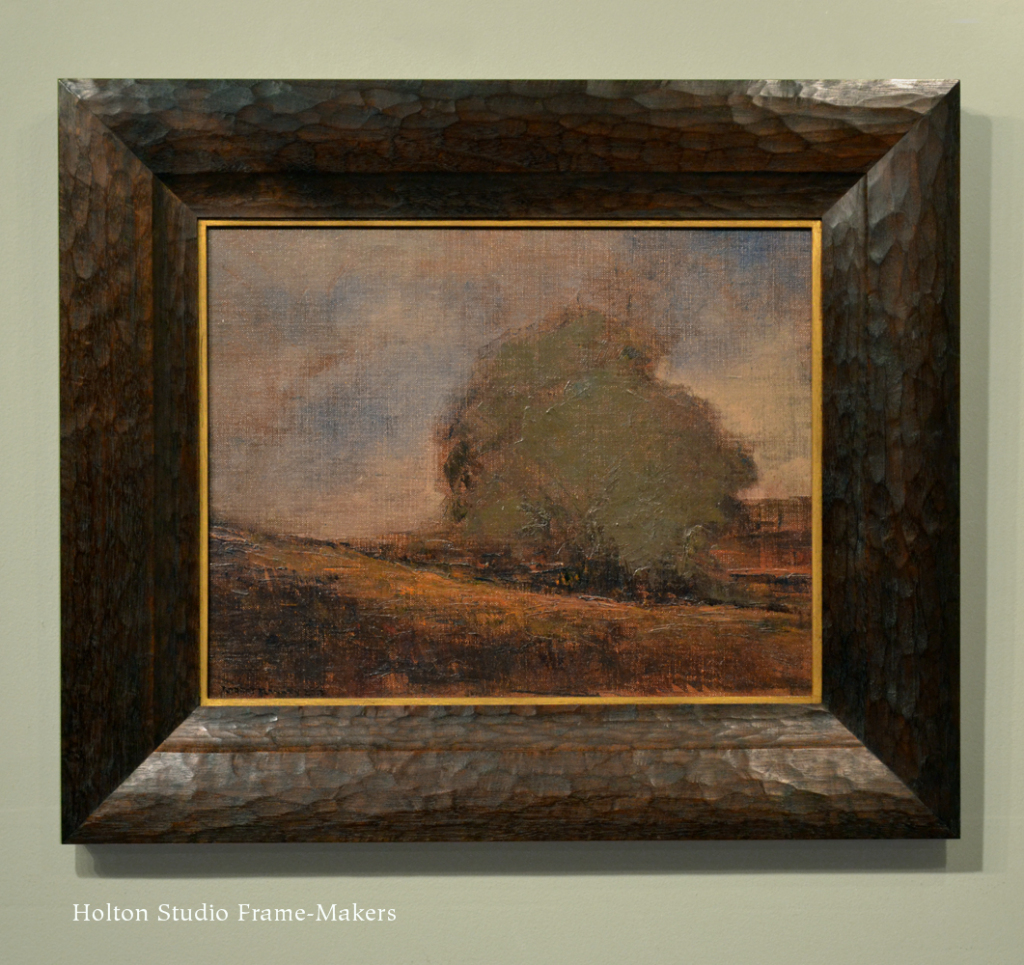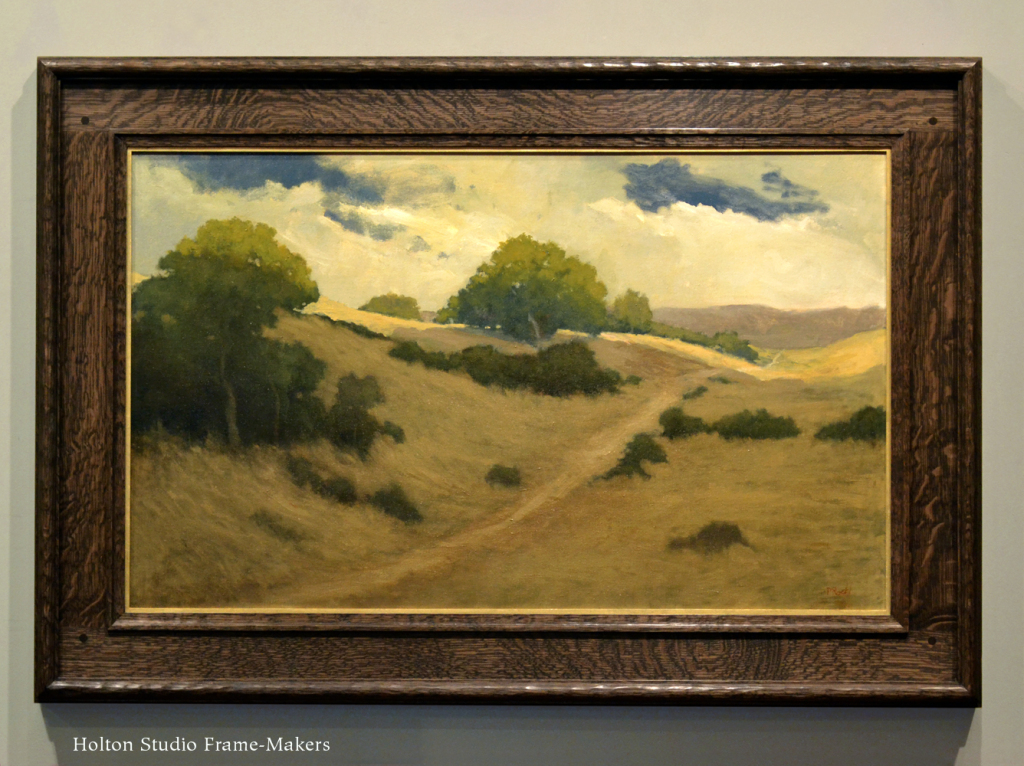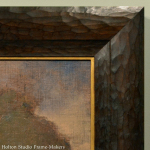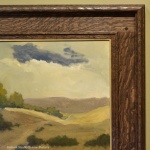We are in the final stages of framing and preparing the gallery (a minor remodel is underway!) for next Saturday’s opening of our show, “A Continuous Harmony: New Tonalist Paintings by Robert Flanary and Paul Roehl.” The reception for these wonderful artists will be from 5 to 7 in the evening. I do hope you can join us. A full preview of the show is here.
Here are two paintings to be featured: “Grove on a Hillside, Blue, Grey Sky”, by Robert Flanary; and “Sierra Foothills” by Paul Roehl. In addition to building picture frames, I’ve been framing, in words, the animating spirit, the artistic inspiration behind the show. A blog post featuring a couple of prime examples of the paintings in the show seems a good place to also include some curatorial thoughts on the show.
First things first:

Robert Flanary, “Grove on a Hillside, Blue, Grey Sky”, 11″ x 14″. Frame in carved walnut with gilt liner. View large…

Paul Roehl, “Sierra Foothills”, 22″ x 36″. Carved cassetta frame in stained quartersawn white oak, with gilt liner. View large…
Framing Tonalism
If you’re a fan, as I am, of the writer Wendell Berry you may recognize the title of the show from the name of a collection of his essays (thank you to Sara Atwood for recommending them to me!). Yes, I stole the name, but Mr. Berry himself stole it: in the epigraph of the book he quotes the mountaineer Thomas Hornbein. Reflecting on his encounter with the Himalayan people and how they live in relation to the landscape, Hornbein wrote that
[T]here was no impression of nature tamed. It seemed to me that here man lived in continuous harmony with the land, as much and as briefly a part of it as all its other occupants. He used the earth with gratitude, knowing that care was required for continued sustenance…In this peaceful co-existence, man was the invited guest.
“Continuous harmony with the land” is a notion most of the modern world seems to have lost. And there’s no more plain evidence of that than the established so-called Art World’s abandonment of landscape painting and disdain for harmony. Yet we only need to go back a hundred years to find a vital instinct for finding and honoring the primal harmony and unity between the human race and the natural world that did, after all, give birth to us; and that artists and those concerned with art revered such things. For example, in 1913, Stanford University professor Edward Howard Griggs wrote in his book The Philosophy of Art: The Meaning and Relations of Sculpture, Painting, Poetry and Music that
“All art…draws its forms ultimately from nature. Thus the final principle of all appreciation of beauty lies in the relation we sustain to the nature world.” (My italics.)
Such views were commonplace, and I choose this one primarily for its local origin. The Bay Area and northern California naturally bred such views. My last post showed a couple of paintings by one of our greatest local painters, William Keith, one including his good friend John Muir. The two men shared a passion for sustaining that relation to nature which Griggs addressed. Keith, along with Arthur Mathews, played a significant role here in the Bay Area in the widespread tendency of the day—not properly a movement—often identified as tonalism. (Keith and Mathews were each students of leading tonalists George Inness and James McNeil Whistler, respectively.) Again, Professor Griggs wrote eloquently of its spirit:
“[T]he beauty of the landscape is not in the lake, river, forest, hills or sky; but in all these fused together in a harmonious whole. Similarly, the beauty of a Corot painting is not in the misty group of trees, the dancing figures, the mellow dawn light or the subtle atmosphere, but in the composition of these into a harmony.”
Such concerns strike many as not only outdated, but a betrayal of the iconoclastic mission they suppose has been eternally assigned to artists to subvert all that’s come before, transgress, and—for it’s a radically evolutionary mission—never repeat or produce even a semblance of what’s been done before. And yet, as Arthur Mathews wrote, “[W]oe to him who believes that he may cut loose from all precedent.” Evolution may have other directions in mind for us—such as cultivating the earth and the arts of living on it.
At least one artist, having thoroughly explored the modern art scene, has ideas of where to go from here. Paul Roehl writes,
My interest in a tonal approach to painting is predicated on a continuing interest in nature as something mysterious and beautiful and finally compelling, as well as a way out of what seems to me a kind of hopelessly fractured dead end in the world of contemporary art… I looked to the past as a way forward and I found the Barbizon painters, their legacy and influence in American and California painting, a resulting tonalism and ultimately an approach to art that seemed to defy temporary fashion and offer continued possibilities.
Continued possibilities are, after all, what we seek, aren’t they? Instead of the fractured world we’ve created, we need to restore harmony—from the Greek, harmos: “joining”. If landscapes “have been done” that hardly seems like a reason to ignore the landscape and “the relation we sustain to the nature world”—to stop seeing it, to stop seeking harmony in it. We cannot be done with nature as long as nature is not done with us.
A final note: The gallery improvements are pretty simple but will mean a dramatic enhancement to and expansion of the display of paintings. We’re very excited about this change and think you’ll enjoy it. (And come check out our ingenious solution to where to put all the displaced corner samples!)
Hope to see you next Saturday!
Again, you can preview the show here…
Frame details—
- Frame detail, R. Flanary, “Grove on a Hillside, Blue, Grey Sky”
- Frame detail, P. Roehl’s, “Sierra Foothills”
- Frame detail, P. Roehl, “Sierra Foothills”



Jehoshaphat Escalante liked this on Facebook.
I wish I could be there. my first visit was memorable and delightful. beautiful paintings and beautifully crafted frames. all said with envy.
Paul Roehl liked this on Facebook.
Daniel WK Chow liked this on Facebook.